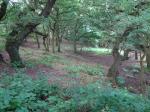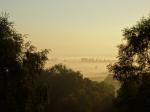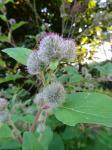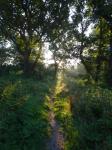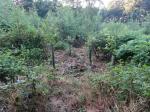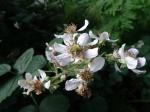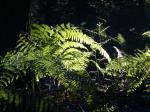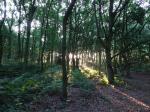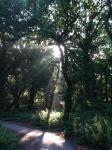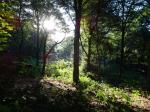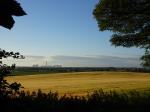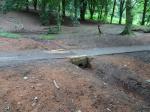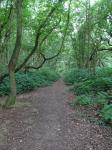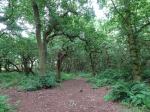Brayton Barff Through the Seasons.
Set in the Vale of York, South West of the market town of Selby and between the villages of Thorpe Willoughby and Brayton, lies Brayton Barff, a sandstone Hill approximately one hundred and fifty feet in height which was formed by glacial movement during the last Ice Age. It is a significant landmark in an otherwise flat landscape.
Today the site is primarily owned by Yorkshire Water with Selby District Council owning a small patch of the land adjacent to the A63 Selby bypass. A large underground reservoir occupies the centre of the site which delivers water to around 4.7 million customers throughout Yorkshire.
Within the Barff woodland over 40% of the trees are Sessile Oak which are generally found in semi natural woodlands in the north of the country. These trees are so called because its acorns are not held on stalks, like those of the English Oak (Pedunculate), but attached directly to the outer twigs. There are also several English Oak trees as well as some cross-hybrid oaks. These trees are known to support many species of flora and fauna, invertebrates, mosses, lichen and fungi.
During the Victorian times it is thought that the shipbuilders on the east coast would come over to the Barff for selected cuts of timber to build their sea going vessels.
The Barff also has a variety of other trees including Silver Birch, Beech, Sycamore, Holly, Rowan, Scots Pine, Alder, Hawthorne and European Larch. There are also several Yew, Willow, Hazel, Horse Chestnut and Wych Elm. As with similar woodlands there are a variety of bushes, including Honeysuckle, Elderberry, Gorse, Broom and Buddleia.
The history of Brayton Barff is quite vague, apparently during 1803 a beacon was lit on the Barff when the country was threatened with an invasion by Napoleon. In May 1935, to celebrate King George V's Silver Jubilee, a Bonfire was lit on the Barff as part of the celebrations.
Early issues of Ordnance Survey Maps dated 1903 clearly show a rifle range on the Barff, extending out to Mill Lane. During the 
Between 2001 – 2004 the A63 Selby bypass, 10km twin lane single carriageway was constructed which severed the South West corner of the Barff, adjacent to Selby Golf Course and resulted in a slight redesign of several holes on the golf course. Wooden fencing was erected as a result of this new road running alongside of the Barff and a footbridge constructed over the ‘new road’ following the line of the Bridal way which extends from Mill Lane. Around 2005/2006 a definite 2metre wide limestone aggregate footpath was laid forming a circular path around the outer edges of the woodland. This footpath is approximately 1.2 miles in length and takes about 30 minutes to circumnavigate at a leisurely pace.
In 2012 the Barff was declared an Ancient Oak Woodland and as such throughout 2012 and 2013 significant work had been carried out by the relevant agencies to cut and remove large swathes of non-native trees, creating at that time huge scars on the landscape. Some three years later the planting of the native trees have become well established and are flourishing. Ongoing maintenance work on the footpath around the bottom of the Barff was completed during the Summer of 2016.
A second phase of woodland maintenance commenced during the Autumn of 2019 with the removal of many old and diseased trees and the cutting back of the Gorse and Broom bushes, especially adjacent to the ‘bypass trail’, this work continued through till March 2020 with re planting continuing into April 2020.
Brayton Barff is a popular site for walkers and bird watchers alike and a path circling the outer perimeter of the Barff makes a pleasant thirty minute walk, giving views looking over towards Selby and the village of Brayton as well as the power stations of Drax and Eggborough..jpg)
For the early risers it is a great place to see some stunning sunrises over the villages of Brayton looking towards Drax Power Station, the same with the Sunsets looking over towards Eggborough and Monk Fryston.
The Barff changes with the Seasons and every visit can reveal something new, the woodland is a haven for wildlife. Records show that since 1982 one hundred and twelve species of bird have been seen in the woodland and at least 40 of those have bred here, including Tawny Owl, Buzzard, Green Woodpecker, Spotted Flycatcher, Goldcrest and Nuthatch to name just a few. On average over 70 species of bird are recorded each year. Further details of the bird life on the Barff can be found on the Brayton Barff Group Facebook page, especially the posts from Derek Cooper. Today ‘The Friends of Brayton Barff group’ led by Derek and a small team of volunteers help keep and maintain the cleanliness of the site as well as recording the wildlife and bird sightings.
The Barff is also home to fifteen different species of mammals, including Muntjac Deer, Pipistrelle Bat, Fox, and Field Vole.
Over eighty species of plant and wildflowers have been recorded, included Bee Orchid, Northern Marsh Orchid, Wood Anemone, Marsh Ragwort, Bluebell, White Bluebell, Bittersweet and Purple and White Foxgloves. Over twenty species of Butterfly have been recorded, including Marbled White, Brown Angus, Speckled Wood, Comma and Brimstone.
During the Autumnal months fungi thrives in this woodland environment, species including Fly Agaric, Beefsteak Tree Fungi, Chicken of the Wood, Sulphur Tufts, Stinkhorn, Ink cap, Puffballs and Hoof Bracket are just some of the many varieties that can be found here.
Click on the galleries shown below to expand the albums.
Summer morning walk around the Barff
An early morning walk amongst the woodland of Brayton Barff is always quite magical and even more so at first light, just as the sun is rising above the tree line.
Since early 2016 I have been walking on the Barff with Meg & Gracie at the break of dawn, firstly because their puppy body clock is geared to wake up at first light and secondly if I don’t get up when I hear them downstairs they will cause havoc and mayhem in the kitchen.
It is a great time of day to be out walking, the air is crisp, the light is generally good and there are very few people about. It has not been uncommon for the temperature to be around 15C at 5.30am and the humidity around 70%. For the majority of my dog walk around the Barff I try to avoid the main circular path around the outside edge of the woodland. I tend to follow the small unmarked tracks through the trees; the downside to this is that most mornings after a heavy overnight dew or heavy rain you can finish your walk absolutely soaked to the skin.
At this time of year, late July 2016 and the middle of summer, the grass and wild flowers have grown to ridiculous heights, the Foxgloves many standing at over six foot in height have just about finished flowering, Rosebay Willow herb and the invasive Himalayan Balsam are still flowering profusely. The Orchids have finished flowering, Clover and Buttercup have also passed their best and being out grown by the grasses. Spear Thistle, Teasel and Marsh Thistle many standing at over six foot in height are still flowering although the Marsh Thistle is beginning to turn and the Goldfinch are busily pulling out the seed fibres. The Lesser Burdock seems to have come to life this week with its prickly purple heads attracting the insects, at ground level the Selfheal has had a good year but is being out grown by the grasses but the Tufted Vetch seems to be thriving with clumps of it creeping through the grasses and bramble along the path around the top of the Barff.
The view from the top of the Barff looking towards Selby and York can be amasing on a clear day, looking Northwards you can often make out the twin towers of York Minster, this year though we have had several inversions which have shrouded the lowlands with mist.
Green Woodpeckers are still actively calling around the Barff, one of these days I will actually see one. Lots of juvenile Robins can be seen hopping from tree to tree along with Chaffinch, Great and Blue Tits. Grey Squirrels are plentiful, I often watch two and sometimes three of them chasing each other around the tree trunks and running along branches at break neck speed. I found what looked to be a dead mole near the top of the Barff this morning, it looked in good condition so what had happened to it I don’t know, it will make a nice meal for one of the Tawny Owl chicks born earlier this year.
The early morning light shining through the trees casts magical shadows over the woodland floor, the ferns glistening with the dew drops. Many of the holy bushes have had their new growth cut back by the deer that come onto the Barff late in the evening, leaving the debris on the floor in the morning. The Oak trees are bearing tiny little acorns at the moment and the Elderberry flower heads are just beginning to turn to berries, plenty of food for the birds and squirrels when Autumn arrives.
|



